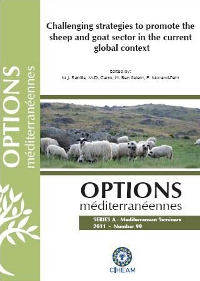| Article précédent | p. 223-226 | Article suivant |
The effect of naringin on plasma lipid profile, and liver and intramuscular fat contents of fattening lambs
Forty Assaf fattening lambs (initial age 14 weeks) fed barley straw (200 g/day) and concentrate feedstuff (30 g/kg BW per day) including 1.5 g naringin/kg DM (NAR group, n=10 males and 10 female lambs) or not (CONTROL group, n=10 males and 10 female lambs) were used to study the effect of this flavonoid on plasma triacylglycerol (TAG) levels, and liver and intramuscular fat content. All the animals were blood sampled on day 0 and thereafter with a weekly frequency. The experimental period lasted 7 weeks and 20 animals (ten per group) were slaughtered. During weeks 2 and 3 a significant (P<0.05) fall in plasmatic TAG levels of the male lambs corresponding to the NAR group could be observed when compared to the CONTROL ones. Thereafter until the end of the experimental period no more significant differences on plasmatic TAG levels were observed. The naringin effect could be related to an inhibitory effect of flavonoids on TAG synthesis. The lacking of effect of this flavonoid at the end of the experiment might be related to changes in ruminal bacterial community. With regard to liver and intramuscular fat content, these parameters were not statistically different (P>0.05) between NAR and CONTROL lambs. In summary, we report a transitory TAGreducing effect of naringin added to the feedstuff for fattening lambs.
Quarante agneaux de race Assaf en engraissement (âge initial de 14 semaines) ont reçu de la paille d'orge (200 g/jour) et un concentré (30 g/kg poids vif) renfermant 1,5 g de naringine/kg (NAR) ou sans cet additif (TEMOIN) pour étudier l'effet de ce flavonoïde sur les niveaux plasmatiques des triglycérides (TAG) et sur le contenu dans le gras intramusculaire et hépatique. Une prise de sang a été effectuée sur tous les animaux le jour 0 puis une fois par semaine. L'expérience a duré 7 semaines, après quoi, dix animaux par groupe ont été abattus. Pendant la 2ème et la 3ème semaine on a observé une diminution significative des TAG dans les niveaux plasmatiques des agneaux mâles correspondants au groupe NAR et comparés au groupe témoin (P<0.05). A partir de ce moment-là et jusqu'à la fin de l'expérience nous n'avons plus observé de différences dans les niveaux des TAG. L'effet de la naringine semble être en rapport avec un effet inhibiteur des flavonoïdes sur la synthèse des TAG. L'absence d'effet de ce flavonoïde à la fin de cette expérience pourrait être la cause des changements dans la population bactérienne du rumen. Le contenu de gras du muscle et du foie n'ont pas été différents (P>0.05) entre les agneaux NAR et témoin. En résumé, nous obtenons un effet réducteur transitoire des TAG quand on ajoute la naringine au concentré pour les agneaux d'engraissement.
- [ Afficher ]
- [ Télécharger ]
- [ Exporter la citation ]
Vous pouvez télécharger la citation au format :
- [ Imprimer ]
-
Mots-clés
AGNEAU, FLAVONOIDE, METABOLISME DES LIPIDES, TRIGLYCERIDECiter cet article
Bodas R., López-Campos O., Prieto N., Giráldez F.J., López S., Andrés S. The effect of naringin on plasma lipid profile, and liver and intramuscular fat contents of fattening lambs. In : Ranilla M.J. (ed.), Carro M.D. (ed.), Ben Salem H. (ed.), Morand-Fehr P. (ed.). Challenging strategies to promote the sheep and goat sector in the current global context. Zaragoza : CIHEAM / CSIC / Universidad de León / FAO, 2011. p. 223-226. (Options Méditerranéennes : Série A. Séminaires Méditerranéens; n. 99). 13. International Seminar of the Sub-Network on Nutrition of the FAO-CIHEAM Inter-Regional Cooperative Research and Development Network on Sheep and Goats, 2009/10/14-16, León (Spain). http://om.ciheam.org/om/pdf/a99/00801560.pdf



